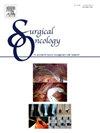“Prepectoral tissue expanders without mesh as a bridge to delayed autologous breast reconstruction: Experience at a single academic center”
IF 2.4
4区 医学
Q3 ONCOLOGY
引用次数: 0
Abstract
Acellular dermal matrix (ADM) is a useful adjunct in implant-based breast reconstruction. The benefits of using ADM with an expander as a temporary bridge to delayed autologous reconstruction are unknown. Placing prepectoral tissue expanders, without ADM, as a bridge to delayed autologous reconstruction could yield cost savings, shorten operating time and decrease complications. This investigation seeks to demonstrate the safety of placing prepectoral tissue expanders without ADM at the time of mastectomy as the first stage of autologous breast reconstruction. A retrospective, chart review was performed at our major academic institution between 2015 and 2020. Included were female patients, 18 years or older at the time of reconstruction, who underwent mastectomy with prepectoral tissue expander placement followed by autologous breast reconstruction at a delayed second stage. Excluded were patients of male gender, younger than 18, patients with lumpectomy only, subpectoral reconstruction, or immediate autologous reconstruction. Data on ADM, patient demographics, comorbidities, and cancer treatment were collected. There were 189 reconstructed breasts of which 56 (29.6 %) used ADM, 131 (69.3 %) did not use ADM, and 2 patients (1.1 %) of unknown ADM use. Expanders were in place for a mean time of 8.9±6.2 months. There was no statistically significant difference in complication rates between the ADM and no-ADM groups. Therefore, not wrapping prepectoral tissue expanders in ADM, at the time of mastectomy, has an equivalent rate of complications compared to ADM wrapping among patients who go on to have second stage autologous breast reconstruction.
"无网眼的胸前组织扩张器作为延迟自体乳房重建的桥梁:单个学术中心的经验"
细胞真皮基质(ADM)是假体乳房重建的有效辅助手段。将 ADM 与扩张器一起用作延迟自体重建的临时桥梁的益处尚不清楚。在不使用 ADM 的情况下放置胸前组织扩张器,作为延迟自体重建的桥梁,可以节约成本、缩短手术时间并减少并发症。本研究旨在证明在乳房切除术时放置胸前组织扩张器(不含 ADM)作为自体乳房重建第一阶段的安全性。我们的主要学术机构在 2015 年至 2020 年期间进行了一项回顾性病历审查。研究对象包括重建时年满 18 周岁的女性患者,她们在接受乳房切除术的同时植入胸前组织扩张器,然后在第二阶段延迟进行自体乳房重建。不包括性别为男性、年龄小于 18 岁、仅接受肿块切除术、胸膜下重建或立即进行自体乳房重建的患者。研究人员还收集了有关ADM、患者人口统计学、合并症和癌症治疗的数据。共有 189 例重建乳房,其中 56 例(29.6%)使用了 ADM,131 例(69.3%)未使用 ADM,还有 2 例患者(1.1%)不知道是否使用了 ADM。扩张器的平均植入时间为 8.9±6.2 个月。ADM 组和未使用 ADM 组的并发症发生率没有明显的统计学差异。因此,在乳房切除术时不使用 ADM 包裹胸前组织扩张器与使用 ADM 包裹进行第二阶段自体乳房重建的患者的并发症发生率相当。
本文章由计算机程序翻译,如有差异,请以英文原文为准。
求助全文
约1分钟内获得全文
求助全文
来源期刊

Surgical Oncology-Oxford
医学-外科
CiteScore
4.50
自引率
0.00%
发文量
169
审稿时长
38 days
期刊介绍:
Surgical Oncology is a peer reviewed journal publishing review articles that contribute to the advancement of knowledge in surgical oncology and related fields of interest. Articles represent a spectrum of current technology in oncology research as well as those concerning clinical trials, surgical technique, methods of investigation and patient evaluation. Surgical Oncology publishes comprehensive Reviews that examine individual topics in considerable detail, in addition to editorials and commentaries which focus on selected papers. The journal also publishes special issues which explore topics of interest to surgical oncologists in great detail - outlining recent advancements and providing readers with the most up to date information.
 求助内容:
求助内容: 应助结果提醒方式:
应助结果提醒方式:


